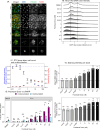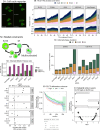This is a preprint.
TNBC response to paclitaxel phenocopies interferon response which reveals cell cycle-associated resistance mechanisms
- PMID: 38895265
- PMCID: PMC11185620
- DOI: 10.1101/2024.06.04.596911
TNBC response to paclitaxel phenocopies interferon response which reveals cell cycle-associated resistance mechanisms
Update in
-
TNBC response to paclitaxel phenocopies interferon response which reveals cell cycle-associated resistance mechanisms.Sci Rep. 2025 Feb 4;15(1):4294. doi: 10.1038/s41598-024-82218-9. Sci Rep. 2025. PMID: 39905117 Free PMC article.
Abstract
Paclitaxel is a standard of care neoadjuvant therapy for patients with triple negative breast cancer (TNBC); however, it shows limited benefit for locally advanced or metastatic disease. Here we used a coordinated experimental-computational approach to explore the influence of paclitaxel on the cellular and molecular responses of TNBC cells. We found that escalating doses of paclitaxel resulted in multinucleation, promotion of senescence, and initiation of DNA damage induced apoptosis. Single-cell RNA sequencing (scRNA-seq) of TNBC cells after paclitaxel treatment revealed upregulation of innate immune programs canonically associated with interferon response and downregulation of cell cycle progression programs. Systematic exploration of transcriptional responses to paclitaxel and cancer-associated microenvironmental factors revealed common gene programs induced by paclitaxel, IFNB, and IFNG. Transcription factor (TF) enrichment analysis identified 13 TFs that were both enriched based on activity of downstream targets and also significantly upregulated after paclitaxel treatment. Functional assessment with siRNA knockdown confirmed that the TFs FOSL1, NFE2L2 and ELF3 mediate cellular proliferation and also regulate nuclear structure. We further explored the influence of these TFs on paclitaxel-induced cell cycle behavior via live cell imaging, which revealed altered progression rates through G1, S/G2 and M phases. We found that ELF3 knockdown synergized with paclitaxel treatment to lock cells in a G1 state and prevent cell cycle progression. Analysis of publicly available breast cancer patient data showed that high ELF3 expression was associated with poor prognosis and enrichment programs associated with cell cycle progression. Together these analyses disentangle the diverse aspects of paclitaxel response and identify ELF3 upregulation as a putative biomarker of paclitaxel resistance in TNBC.
Keywords: cell cycle; interferon response; live-cell imaging; single-cell RNA sequencing (scRNA-seq); transcription factor; triple negative breast cancer (TNBC).
Figures





Similar articles
-
TNBC response to paclitaxel phenocopies interferon response which reveals cell cycle-associated resistance mechanisms.Sci Rep. 2025 Feb 4;15(1):4294. doi: 10.1038/s41598-024-82218-9. Sci Rep. 2025. PMID: 39905117 Free PMC article.
-
Exploring the resistance mechanism of triple-negative breast cancer to paclitaxel through the scRNA-seq analysis.PLoS One. 2024 Jan 16;19(1):e0297260. doi: 10.1371/journal.pone.0297260. eCollection 2024. PLoS One. 2024. PMID: 38227591 Free PMC article.
-
Serial single-cell profiling analysis of metastatic TNBC during Nab-paclitaxel and pembrolizumab treatment.Breast Cancer Res Treat. 2021 Jan;185(1):85-94. doi: 10.1007/s10549-020-05936-4. Epub 2020 Sep 19. Breast Cancer Res Treat. 2021. PMID: 32949350 Free PMC article.
-
Research and experimental verification on the mechanisms of cellular senescence in triple-negative breast cancer.PeerJ. 2024 Feb 29;12:e16935. doi: 10.7717/peerj.16935. eCollection 2024. PeerJ. 2024. PMID: 38435998 Free PMC article.
-
Triple negative breast cancer and platinum-based systemic treatment: a meta-analysis and systematic review.BMC Cancer. 2019 Nov 8;19(1):1065. doi: 10.1186/s12885-019-6253-5. BMC Cancer. 2019. PMID: 31703646 Free PMC article.
References
-
- Bauer K.R., et al., Descriptive analysis of estrogen receptor (ER)-negative, progesterone receptor (PR)-negative, and HER2-negative invasive breast cancer, the so-called triple-negative phenotype. Cancer, 2007. 109(9): p. 1721–1728. - PubMed
-
- Liedtke C., et al., Response to Neoadjuvant Therapy and Long-Term Survival in Patients With Triple-Negative Breast Cancer. Journal of Clinical Oncology, 2023. 41(10): p. 1809–1815. - PubMed
-
- Foulkes W.D., Smith I.E., and Reis-Filho J.S., Triple-Negative Breast Cancer. New England Journal of Medicine, 2010. 363(20): p. 1938–1948. - PubMed
Publication types
Grants and funding
LinkOut - more resources
Full Text Sources
Miscellaneous
